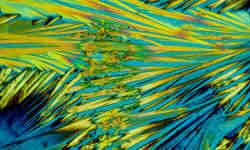

 |
 |
 Biotin Crystals Copied without permission from Roche Product Information |
BiotinBiotin, one of the water soluble B-vitamins, occurs in 8 different forms but only one of these, D-biotin, is found in nature and has full vitamin activity.Did You Know? Biotin is required by Saccharomyces cerevisiae (baker's yeast) for growth. Did You Know? Biotin is used in hair products. Top Chemical Structure Fig.1 The Chemical Structure of Biotin Top Principal Sources in FoodPrincipal dietary sources of biotin include:
Biotin in the BodyBiotin, like many other vitamins in the B-complex, is required for cellular metabolism of carbohydrate, fat and protein. It is also involved in the production of amino acids and glucose, and in the catalysis of fatty acid synthesis.Deficiency is rare, but can result in:
Top StabilityBiotin is quite stable to heat and most of the cooking losses are due to biotin leaching into the cooking water.Top SynthesisThe chemical synthesis of biotin, using fumaric acid as a starting material, was developed by Goldberg and Sternbach in 1949.Top |